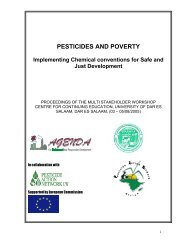Your Daily Poison - Pesticide Action Network UK
Your Daily Poison - Pesticide Action Network UK
Your Daily Poison - Pesticide Action Network UK
You also want an ePaper? Increase the reach of your titles
YUMPU automatically turns print PDFs into web optimized ePapers that Google loves.
◆ A baby girl of 9 months was found by her<br />
parents lying on floor. A broken plant pot<br />
which had compost in it containing<br />
chlorpyrifos was covering her face. The<br />
child appeared to have ingested an amount<br />
of compost. She vomited three times.<br />
c. PESTICIDE POISONINGS REPORTED TO<br />
THE NATIONAL HEALTH SERVICE (NHS)<br />
The National <strong>Poison</strong>s Information Service<br />
(NPIS) is a clinical toxicology service for<br />
healthcare professionals working in the NHS<br />
and is a service commissioned by the Health<br />
Protection Agency. The service consists of a<br />
network of units across the <strong>UK</strong>, providing<br />
information and advice on the diagnosis,<br />
treatment and management of patients who<br />
may have been accidentally or deliberately<br />
poisoned. Information on management of<br />
poisoning is available to registered medical<br />
professionals on TOXBASE, an Internet<br />
database or via a 24 hour telephone service<br />
for more complex cases requiring specialist<br />
advice 12 .<br />
The NPIS changed the format of its annual<br />
reports in 2004, now reporting data in the new<br />
format for a few types of pesticide active<br />
ingredients (Appendix 4b), so comparing<br />
Table 2. Top 20 agents reported to be involved in<br />
exposures, April 2004 to March 2005<br />
Ingredient Number of exposures<br />
Permethrin 84<br />
Paraquat 58<br />
Diquat 57<br />
Glyphosate 56<br />
Metaldehyde 48<br />
Bromadiolone 36<br />
Phenols/cresols* 32<br />
Borax 29<br />
Sodium chlorate 23<br />
Bendiocarb 21<br />
1,2-benzisothiazolin-3-one 21<br />
Difenacoum 17<br />
Tetramethrin 14<br />
Cypermethrin 12<br />
Diuron 9<br />
Chlorpyrifos 8<br />
Pyrethrins 7<br />
Alphachloralose 7<br />
Organophosphate 6<br />
Alphacypermethrin 6<br />
* From creosote but note that creosote has been banned since 2003. However, some members of the<br />
public use ‘creosote’ generically to denote some sort of wood preservative so these may not all be<br />
creosote.<br />
Source: Adams R D, Good A M, Bateman D N, ‘<strong>Pesticide</strong> exposure monitoring using NPIS resources<br />
April 2004 - March 2005’, NPIS Edingburgh<br />
earlier reports directly is not possible.<br />
Telephone enquiries to the NPIS do not<br />
necessarily represent numbers of poisonings<br />
because they are often precautionary only. The<br />
NPIS deals with all kinds of poisoning: in<br />
2004/5, the majority (67%) resulted from<br />
pharmaceuticals, and agrochemicals<br />
represented 1% of enquiries (other sources:<br />
industrial chemicals 12%, household 8%,<br />
cosmetics 8%, plants 3%).<br />
The total number of enquiries for pesticide<br />
poisonings in 2004-05 was 739, which included<br />
268 pyrethroids, 137 organophosphorus, 125<br />
paraquat (including two deaths), 120<br />
glyphosate and 89 carbamates. The top 20<br />
pesticides reported as responsible for incidents<br />
are listed in Table 2. In the previous year<br />
(2003-04) the figures were: 102 for glyphosate,<br />
175 for organophosphorus insecticides and 88<br />
for paraquat with one death.<br />
The NPIS is conducting a new surveillance<br />
programme specifically for pesticides 13 using its<br />
online service TOXBASE. The survey was<br />
commissioned by the PSD and HSE following<br />
work by the ACP on improving the surveillance<br />
of pesticide-related ill-health. In total,<br />
information on 588 pesticide-related exposures<br />
was collected from telephone and TOXBASE<br />
enquiries. This represents an improvement in<br />
the surveillance and reporting of pesticide<br />
poisonings. The scheme is voluntary, and it is<br />
unknown how many more cases would be<br />
reported if it was mandatory. Although<br />
information on headlice products was also<br />
collected, it was not included in the report to<br />
the PSD, because it is the Medicines and<br />
Healthcare Products Regulatory Agency<br />
(MHRA) which regulates these products.<br />
At their meeting in November 2005, the ACP<br />
considered the pesticide exposure monitoring<br />
report from the NPIS and commented that<br />
‘most incidents were relatively minor, and that<br />
those which were more serious tended to arise<br />
from intentional poisoning.’<br />
d. PESTICIDE EXPOSURES REPORTED TO<br />
LOCAL AUTHORITIES<br />
Incidents are still reported to local authority<br />
environmental health departments (Appendix<br />
4c) despite the publication by the HSE of an<br />
accessible leaflet 14 to the public on reporting. In<br />
2002, over half of the local authorities (see<br />
the second <strong>UK</strong> pesticide exposure report 5

















